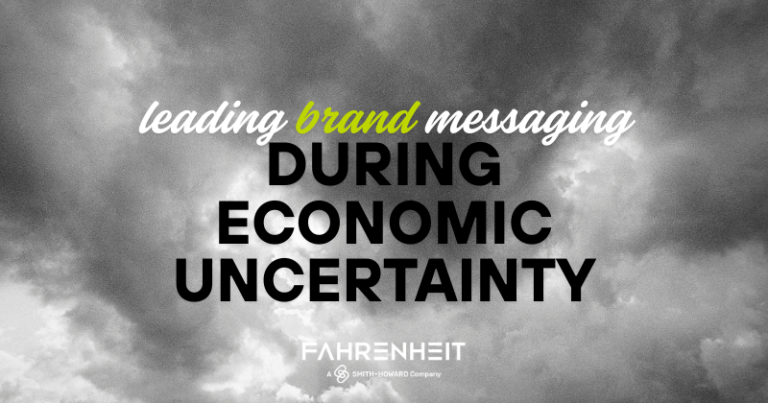Leading Brand Messaging During Economic Uncertainty

Economic uncertainty doesn’t just affect markets, it reshapes consumer behavior. As businesses and individuals tighten budgets, decision-making becomes more cautious, brand loyalty weakens, and trust becomes harder to earn. Messages that once resonated may now seem out of touch, leaving gaps in brand communication that can create confusion, hesitation, or even skepticism among stakeholders.
For the C-suite, this moment demands more than just reactive messaging; it requires a strategic approach that reassures stakeholders, reinforces trust, and keeps the company positioned for long-term stability. The goal isn’t simply to communicate, but to communicate in a way that acknowledges challenges, reinforces company values, and provides the clarity and confidence stakeholders need.
Be honest About challenges
Transparency is crucial during uncertain times. Stakeholders, whether employees, customers, or investors, value honesty over polished, overly optimistic messaging. If there are unknowns, it’s okay to acknowledge them rather than trying to provide incomplete answers. A “candid over charisma” approach fosters trust and demonstrates credibility. By being upfront about challenges, leaders can ensure that their messaging does not create false expectations or erode trust when realities shift.
reinforce core company values
In times of instability, a company’s values act as an anchor. Leaders should consistently reinforce what the company stands for and how those principles guide decision-making. This provides stability for employees while also reassuring external stakeholders that the company remains committed to its mission, even in turbulent times. Messaging should highlight how the company’s core values influence both immediate responses and long-term strategy.
Tip: If your company values don’t resonate during times of turbulence, it may be a sign that they won’t stand the test of time—consider re-evaluating and refining them to ensure they truly reflect your organization’s purpose and resilience.
encourage open communication
Effective messaging is not just about what is said but how often and through which channels. Leaders should establish a cadence of communication through multiple platforms such as team meetings, company-wide emails, and internal chat forums to ensure that key messages are consistently reinforced. Employees should also know where to turn for further discussions, whether it be their managers, HR, or leadership teams. Open dialogue creates a sense of inclusion and ensures that concerns are acknowledged and addressed.
be an outlet for the team
Economic uncertainty can lead to stress and burnout. Leaders should recognize what their teams need and create opportunities to address those needs. Whether it’s a town hall to address concerns, a team-building activity to boost morale, or even a surprise lunch from a local favorite, small gestures can make a big difference. Providing these outlets signals that leadership is paying attention and values employees’ well-being.
lead with empathy and authenticity
Not everyone experiences uncertainty in the same way. Leaders must recognize that employees have different personal and financial circumstances that may shape their perspectives. Demonstrating empathy by listening actively, acknowledging concerns, and providing reassurance helps maintain trust. At the same time, authenticity is key. Employees and stakeholders can sense when messaging feels forced or insincere. Leaders should communicate in a way that aligns with their personal style and company culture, rather than adopting an artificial tone.
demonstrate strength and resilience
In uncertain times, strong leadership provides much-needed stability. Employees look to leaders for confidence and direction. While honesty and empathy are crucial, so is instilling a sense of resilience. Leaders should remind teams of past challenges the company has overcome and highlight the strengths that will carry them forward. A message of resilience, backed by concrete examples, reassures stakeholders that the company is prepared to navigate uncertainty successfully.
Ultimately, the C-suite’s brand messaging during economic uncertainty should be rooted in honesty, consistency, empathy, and strength. By reinforcing core values, maintaining open communication, and demonstrating resilience, leaders can instill confidence in employees and stakeholders, ensuring the company emerges stronger from any challenges ahead.
author
 Brielle Ferrante delivers strategic marketing leadership to businesses seeking to accelerate growth, elevate their brand, and build high-performing marketing functions. With experience spanning consulting, corporate leadership, and entrepreneurship, she brings a holistic and data-driven approach to modern marketing challenges.
Brielle Ferrante delivers strategic marketing leadership to businesses seeking to accelerate growth, elevate their brand, and build high-performing marketing functions. With experience spanning consulting, corporate leadership, and entrepreneurship, she brings a holistic and data-driven approach to modern marketing challenges.
As fractional Chief Marketing Officer, Brielle partners with companies to refine their marketing strategies, align teams around growth priorities, and implement scalable, innovative marketing solutions. Her ability to navigate ambiguity and lead through change allows her to quickly assess business needs and design marketing roadmaps tailored to each organization’s goals and culture.

